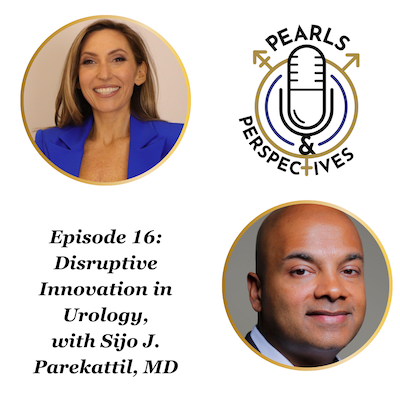Opinion
Video
Dayna R. Smerina and Amy M. Pearlman, MD, discuss their research in sexual medicine
Author(s):
Smerina and Pearlman discuss recent research collaborations in the field of sexual medicine.
In this video, from the 2025 Desai Sethi Urology Institute Urology on the Beach meeting, Dayna R. Smerina and Amy M. Pearlman, MD, discuss their research projects in sexual medicine. Smerina is an OMS-3 at the Dr. Kiran C. Patel College of Osteopathic Medicine at Nova Southeastern University in Fort Lauderdale, Florida. Pearlman is a urologist and co-founder of the Prime Institute in Coral Gables, Florida.
Transcription:
Pearlman: Hi, folks. My name is Dr Amy Pearlman, and I have Dayna Smerina here with me. Dayna and I met over a year ago at a Broward County journal club. She was presenting on a person who had come into the clinic with a testicular mass, and she crushed her presentation. So sitting next to her during that dinner, I said, "Dayna, are you looking to do some research?" And over that 1-year span, we've actually worked on a lot of research together. The first project that we worked on together was writing a chapter on sexual enhancement products. The challenging part of that was, there's not much research in the literature. But the easy part is, there's not that much research in the literature. So how do you write a chapter when there's not a lot of research? What were some of the challenges you faced when you were doing that literature search?
Smerina: Obviously, [there was a] limited amount of research, and then even if there was a case report, it was a case report from the 1980s in Italy. It also brings up how important it is to have those personal case reports of someone's journey, because even though it's that person's individual journey, other people can relate to it. I remember one thing that I added in that chapter was this man who had erectile dysfunction after prostate cancer, and his lesbian friend was trying to encourage him to use a prosthetic penis, basically. That is not a medical device at all, but he found that he was able to have a meaningful sex life again with his wife by using that, and it was because he had that person encouraging him. And that experience very much can be generalized to a lot of post-prostatectomy or even any other type of treatment to the prostate. Even though it was a single case report and it was a personal journey of this 1 patient, I think that actually has some power in it as well, that other people can relate to it...And so I remember that the most out of that chapter that we wrote.
Pearlman: I think [that was] one of the more fun chapters that I've worked on throughout my career. It really just goes to show that in a space where there's not much research, those case reports will really be the bulk of what we're writing in a chapter. Even if there's 1 patient or 5 patients or 10 patients, that matters. And I think that's a call to action for people in the sex tech industry. A lot of people come to me as a consultant, and they say, "how many patients do I need to include?" And if it's a data-free zone, I just say, "just 1 to start or just 5 to start." You don't have to have a whole bunch of patients, but you need something in the peer-reviewed literature, so when people like us are writing chapters, we have something to reference.
Something else that we worked on shortly after that was a video collection for an online journal that publishes videos on sexual medicine. We got to interview people from around the country, people like Dr Tori Mallow, who is a pelvic physical therapist in the Delray area; people like Dr Rachel Rubin, who has a practice in DC; Dr Lisa Paz, who is a sex therapist. The goal was to show people and other urologists and colleagues, how do you actually talk about sex toys to your patients? What is the role of a sex therapist in that discussion? What is the role of a pelvic physical therapist in that discussion? What were some of the learning points that you took away from hearing, how does the sex toy conversation play out with different specialists?
Smerina: So I think that it's definitely a multi-disciplinary approach and that everyone has their role. We went to the physical therapist's office, which was so cool. We saw the physical therapy exercise room with all her instruments. And then, when you re-watch the video, you could see the sex therapist and how important it is to maybe involve the partner in these conversations. And so I think the overall thing was that [there needs to be] open communication with the patient and all these specialists. And sometimes that could be hard to coordinate, but if a patient doesn't know to maybe bring up these concerns to their PCP or their urologist, or maybe they go to a physical therapist for something else, and that physical therapist knows a pelvic floor specialist, and I think it's just putting these ideas out there so that it might reach the right person 1 day and they could feel empowered enough to talk about it with their doctor.
Pearlman: I think one of the reasons why I was really excited about creating that video montage is, let's say there's a provider that doesn't feel comfortable having that discussion, or simply doesn't have the time, because it does take time. Maybe their exit strategy in that scenario is, maybe they just introduce the video link, and they say, "This is a little bit out of my expertise, but there's a great 10-minute video that you can watch that will give you all the information you need about using sexual wellness products." I think at the very least, that's what I hope the video can do for people.
Now, let's fast forward a little bit to the current research that we're working on, which is looking at detumescence time. I would say this pilot work that we're doing is honestly the most challenging that I think we've worked on over the last year, because there is literally nothing in the scientific literature that looks at detumescence. We just assume that [detumescence] is normal and that that's going to happen. But the question is, can we do anything about it? And so we did a pilot study of 21 patients using a device from FirmTech [called] MaxPR, which is a fancy erection ring. Our goal was to figure out,can we prolong detumescence time in men who take PDE-5 inhibitors, in men who use this erection ring, and what happens when we combine those therapies? When we think about why this question even matters, well, it matters for a lot of reasons. Women just take longer to reach climax. If that guy can prolong his detumescence time, where he's still in the game for maybe another minute, 4 minutes, 5 minutes, that could be a game changer in terms of a heterosexual couple. Or if someone is suffering from premature ejaculation, he orgasms, but he can still penetrate for a couple more minutes. Again, that's another game changer. Why don't you talk about some of the findings from this study?
Smerina: The combined therapy was the best with the MaxPR ring and the medication, but then comparing the MaxPR ring with the medication, it was actually kind of equal. Maybe this is a chance for patients to say, "I don't want to take the medication. It interferes with my other medications," or, "I have ED and I'm an older gentleman [with] a lot of other comorbidities, and I don't want to take this extra pill." And so I just think, even if it doesn't mean that one's better than the other, I think it's just people having the options and talking about it more will just make everyone's experience better.
Pearlman: Absolutely. And then I think looking on the horizon of the things that both of us are interested in, and one of the reasons why I'm also at the Urology on the Beach conference is I love hearing about the new technologies. We talk about sex technologies, and now I'm kind of coining the term "toilet tech" advancements. When we think about what's on the horizon, a lot of people get a little bit nervous when it comes to artificial intelligence sort of invading the medical space, but there's so much opportunity for using artificial intelligence and machine learning. That was really the fourth piece of work that you and I have worked on, is you were writing a review paper on the implications and the implementation of artificial intelligence and machine learning and wearable devices in sexual medicine...What were some of your take-home points from that?
Smerina: I think my take-home point was how vast the information can be with artificial intelligence. Artificial intelligence can make artificial data. We basically were writing about how you can give the robot a data set and say, "Our data set isn't big enough. Can you make up fake patients that kind of fit the data set?" And so now we have a bigger data set, and we can make more predictions, more solid predictions, from it. We really didn't have those extra patients. [The AI] knows how to make a fake data point. And you might say that we shouldn't have fake data points. But then with HeHealth, they were doing it with the M pox outbreak, and with just a few Mpox photos, the robot made more and then the robot was able to learn from the photos it made. It sounds pretty exciting to me.
Pearlman: I'm excited about the use of AI. Part of that paper, too, was talking about, what are the ethical implications? We can't talk about the exciting points of AI without the ethical implications. Especially in this sexual medicine space, we have to think about discretion and if someone is sending a photo, what happens to that photo, and where is the data stored, and can it ever be tied back to that person? I like that, in writing this paper together, we learned, what are those targeted things that companies are doing to make sure that the data are safe and are used appropriately. That was a big learning point for both of us as well.
Smerina: It is, and you feel an ethical responsibility that you are the one advocating for this, and also that these are people's intimate parts and intimate parts of their personal life, and I think that showing them that it could be safe, and then also saying, "This is what HeHealth has done, and this is what these other companies have done," that once the picture is reviewed by the physician, it's gone, and just reiterating that to gain trust. Because if there's no trust, then's no one's going to use the technology and it's really useless. So I think it's again, just about communicating with people and gaining trust.
Pearlman: I'm excited for some more of the work that we're going to be working on. Stay tuned. AI and wearable technology are really all the rage in 2025.
This transcript was AI generated and edited by human editors for clarity.
Newsletter
Stay current with the latest urology news and practice-changing insights — sign up now for the essential updates every urologist needs.

















